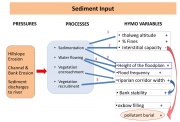Sedimentation and sediment input
Contents
Sedimentation and sediment input
04. Morphological alterations
General description
Delivery of sediment from hillslopes to river systems is heavily disrupted by human activities. The nature of the disruption varies widely according to the broad environmental context as well as the nature of the human activities. Sudden discharges of sediments to rivers can occur in relation to natural processes such as major bank erosion, slope mass movements and glacial meltwater outbursts. However, these natural events cannot be viewed as ‘pressures’ unless they are accelerated by human activities.
Effect/Impact on (including literature citations)
- Hillslope erosion
Silt and fine sediments that clog interstices in river beds and cause colmation are mainly produced by forestry and agriculture (Brunke and Gonser, 1997). Clogging reduces the numbers and activity of hyporrheic invertebrates, which in turn, affects the porosity of interstitial sediments through the absence of their feeding and burrowing (Brunke and Gonser 1997). Jacobson and Gran (1999) found that agricultural development in the Ozarks, USA, contributed gravel-sized sediments to the Current River, Missouri. Fine sediment inputs to rivers come from bank erosion of fine floodplain sediments and erosion of the soil surface. The latter is strongly affected by land use and management, and increases for the same soil and land use with increases in topographic slope. As soil erosion becomes increasingly accelerated (i.e. exceeds the rate of soil production), finer soil particles are removed and gullies develop, channeling flows of water and allowing mobilization of coarser sediments. Where drains are constructed to remove surface water, these make delivery of sediment to river systems more efficient, and if their gradient is sufficiently steep, they may become sources of both fine and coarse sediment, as has been observed in drains associated with commercial forestry. Superficially, delivery of coarse sediment might offset gravel losses from river bed mining, but both processes would have to be in balance. Large accumulations of instream sediment can lead to channel instability, a decrease in channel capacity, and remobilisation of silt stored in floodplain sediments by overbank flows (Jacobson and Gran 1999, after Hancock 2002). Dirt roads, particularly those associated with forestry have been widely recognized as important sediment sources, conduits for sediment and water, and potential locations from which landslides may be triggered (Brunke and Gonser, 1997; Forman and Alexander, 1998).
- Sediments discharges to rivers
Slugs of sediment are also introduced into rivers directly as a result of human activities such as accidental dam breaching or deliberate dam removal. Bednarek (2001) showed that dam removal produced an increased sediment load causing suffocation and abrasion to various biota and habitats. However, observations of several dam removals suggest that these increased sediment loads are a relatively short-term effect. Deliberate flushing of sediment from reservoirs can release excessive fine sediment pulses into the river causing fine sediment infiltration and burial of the river bed. The Cachí Reservoir on the Reventazón River, Costa Rica, is flushed on an almost yearly basis. The material was found to both deposit in between flushings and to be eroded during flushing, mainly in the uppermost and lowermost parts of the old river channel. A major factor in explaining the amounts and distribution of deposits was shown to be the phase lag between water discharge and suspended-sediment concentration peaks (Brandt and Swenning 1999). Such sediments can be mobilized by larger flow releases from reservoirs, and methods are available to clean fine particles from gravel at specific sites, including pump-washing, high-pressure jet washing, and tractor rotovating. However, local loosening of gravel by such methods can lead to resuspension of silt to cause colmation in downwelling zones downstream (Hancock 2002).
Case studies where this pressure is present
- Fish_ramp_Baumannsbrücke
- current_deflector_Eichenfelde
- Klompenwaard
- Negro
- Manzanares
- Regelsbrunner_Aue
- Klein_Wall
- Fish_ramp_Friedrichsgüte
- Vén_Duna_-_side_arm_reopening
- Millingerwaard
- Pisuerga._Improvement_of_ecological_state_of_the_river_between_the_dam_Pisuerga_Aguilar_de_Campo_and_Alar_del_Rey_(Palencia)_1st_Stage.
- Fovant_-_Demonstrating_strategic_restoration_and_management_STREAM_(LIFE05_NAT/UK/000143)
- Conservation_of_Atlantic_Salmon_in_Scotland_(LIFE_04/NAT/GB/000250)
- Deva_River._Bank_protection_on_the_right_bank_of_the_Deva_River_in_Molleda
- Sweden-_Restoration_of_the_Freshwater_Pearl_Mussel_and_its_habitats_(LIFE04/NAT/SE/000231)
- Bouxweerd
- Stream_-mending_the_Avon
- Amesbury_on_the_river_Avon_-_Demonstrating_strategic_restoration_and_management_STREAM_(LIFE05_NAT/UK/000143)
- River_Wensum_Rehabilitation_Project_-_Billingford
- Upper_Woodford_-_Demonstrating_strategic_restoration_and_management_STREAM_(LIFE05_NAT/UK/000143)
- Vreugderijkerwaard_-_Side_channel
- Chícamo_Life_project._Conservation_of_Aphanius_iberus´_genetics_stocks_(_Murcia_).
- Tajo._Improvement_of_ecological_state_of_the_Tajo_and_tributaries__riverside_affected_by_the_spill_of_kaolin,_at_Poveda_de_la_Sierra_and_Taravilla_(Guadalajara)
- Woodgreen_-_Demonstrating_strategic_restoration_and_management_STREAM_(LIFE05_NAT/UK/000143)
- Donau_-_Rührsdorf-Rossatz_(LIFE03_NAT/A/000009)
- Donau_-_Aggsbach_(LIFE03_NAT/A/000009)
Possible restoration, rehabilitation and mitigation measures
- Prevent sediment accumulation in reservoirs
- Improve continuity of sediment transport
- Trap sediments
- Favour morphogenic flows
- Reduce undesired sediment input
- Reduce erosion
- Manage dams for sediment flow
- Remove sediments
- Isolation of water bodies
